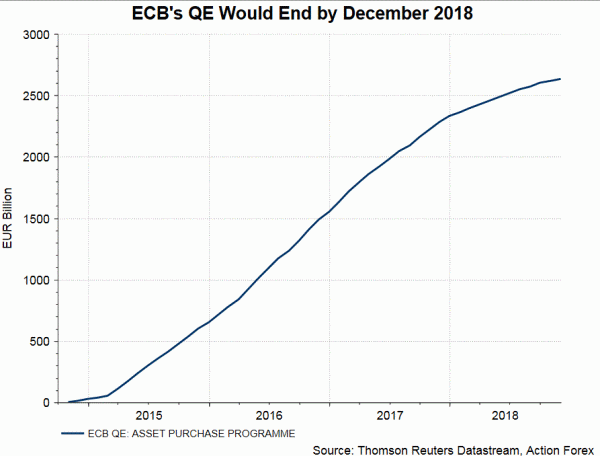The market is closely watching ECB’s policy after QE. At the upcoming meeting next week, ECB would announce its plan to reinvest the maturing bonds. Meanwhile, market speculations are rising that the central bank would soon announce a new round of its targeted long-term refinancing operations (TLTRO). Given recent slowdown in GDP growth in the bloc, it is likely that the staff would revise lower the forecasts on growth and inflation for coming years.
Post- QE Reinvestment
At the previous meeting, ECB kept the main refi rate stays at 0% and the deposit rate at -0.4% and reaffirmed that the policy rates would stay on hold until at least the summer of 2019, to ensure that inflation returns sustainably to the target of below, but close to, 2%. More importantly, it affirmed that its asset purchase program, reduced to 15B euro per month from October to December, would by the end of the month. In order to lessen the disturbance to the market, the central bank, like what the Fed did in 2014, would reinvest the maturing bonds assets after QE ends in December. The focus at next week’s meeting is announcement of the reinvestment plan and schedule.
Earlier this week, the central bank announced the changes it made on the capital key, which is used to determine the proportion of capital each of the national central banks must contribute to the ECB, and the portion of the ECB’s profits they would receive in return. Such measure is adjusted once every five years based on population and GDP data from European Commission. As suggested in ECB’s press release on Monday, 16 national central banks (including Germany, France and Austria) have their share adjusted higher and 12 (including Italy, Spain and Greece) lower. President Mario Draghi noted in July that the central bank would follow the capital key when deciding on reinvestment. Therefore, this change would affect ECB’s portfolio in the reinvestment process. We expect to hear more details next week.
New Round of TLTRO
ECB first launched TLTRO in Jun 2014, followed by another round in March 2016. All operations are expected to mature by June 2020. Market speculations are rising on the scenario that ECB would announce an extension/ or a new round as soon as next week. Through TLTROs, one of the ECB’s non-standard monetary policy tools, ECB provides long-term loans to banks , incentivizing them to increase their lending to businesses and consumers in the Eurozone.
We believe ECB will, and should, launch another round of TLTRO, either this month, or in early 2019. If TLTRO ends as it matures, banks’ borrowing costs would increase. This in turns would result in higher borrowing costs to private sector. Moreover, funding costs for the banking sectors in the periphery, such as Italy, have soared due to an increase in the sovereign bond yield. They are in need of ongoing assistance from the central bank or tighter credit conditions would suffocate the gradual pace of economic recovery in these countries.
ECB’s reinvestment plan after the end of QE aims at maintaining the balance sheet at the current level. A balance sheet that is no longer expanding like the past several years would have tightening effect in the market. Rising lending rates would likely amplify the tightening effect of the removal of the asset purchase program. ECB noted that it would leave the policy rates unchanged at least until the summer of 2019. This is portably under the assumption that all other things being equal, other than the end of QE. We expect an overly tight credit conditions would affect the schedule of ECB’s removal of negative rates, especially when we are facing moderation of global economic growth. We believe new TLTRO should help alleviate the market impact of the end of QE, and pave the way for ECB to gradually remove negative interest rates in coming years.













